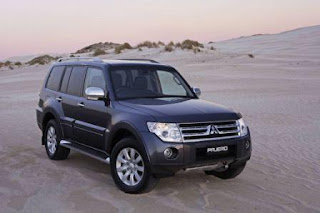
mitsubishi pajero.The turbocharged and intercooled 3200cc diesel gets an 18 percent power boost, to 150kW at 3800rpm.
On sealed roads, the engine drives the rear wheels through a smooth-shifting five-speed automatic gearbox.
It’s part of what Mitsubishi calls its MATT system (Mitsubishi All Terrain technology) that also includes Active Stability Control (ASC), active traction control (ATC), engine brake assist control, a hill holder, and a multi-mode ABS braking system.
The active traction and control system originally fitted to the Pajero was irritatingly intrusive if you were pressing-on on demanding sealed roads with continual direction changes.
Gravel road grip is strong, and the mitsubishi pajero is extremely competent off-road with a useful 225mm of ground clearance, compact approach, ramp-over and departure angles and a go-anywhere 4x4 system.
We’ve driven the mitsubishi pajero in some very tight, ultra-slippery off-road terrain on the North Island’s central plateau where it acquitted itself extremely well.
The diesel is a willing unit and the hefty torque gives the big truck – 1490mm long, 1875mm wide, 1900mm high,3030kg gross vehicle weight – strong pulling power and useful acceleration.
Safety kit includes front and side airbags for driver and front seat passenger and side curtain airbags for all passengers. The four-wheel disc brakes (rears are disc-in-drum) provide solid stopping power; Mitsubishi says the Exceed will stop from 100km/h in 42 metres. There’s a comprehensive trip computer, leather upholstery and trim, the steering wheel is leather-wrapped, and there’s plenty of front and rear cabin space. Front seats offer good comfort and support.
Load-carrying roof rails boost luggage capacity.
Perhaps the single most noticeable downside to the DI-D (direct injection diesel) Pajero is the incredible amount of engine noise.
It really is atrocious, almost embarrassing, and while most diesels seem to only present any sign of engine noise while stationary, the Pajero’s large capacity four-cylinder is raucous no matter what speed travelled.
The real strength of mitsubishi pajero however lies in its 441Nm of torque availed from just 2000rpm.
Loaded with a fat tandem trailer and my 1976 Holden HJ Monaro GTS the Pajero’s 3000kg of braked towing capacity made light of the task, even managing to return 13.6 litres per 100km average while doing so.
Larger hills will knock 10 or 15km/h off the Pajero’s top speed, but with an additional 2000kg on board it’s easy to see why. The ESP system too is a little confused in some instances with wet asphalt seeing the delayed threshold system sustain its intervention for an unnecessarily long period. Reassuringly the Pajero also offers front and side airbags to afford it a four-star ANCAP rating.
Cargo capacity of course varies depending on the car’s configuration, but as a five-seater mitsubishi pajero offers a generous 1081 litres.
